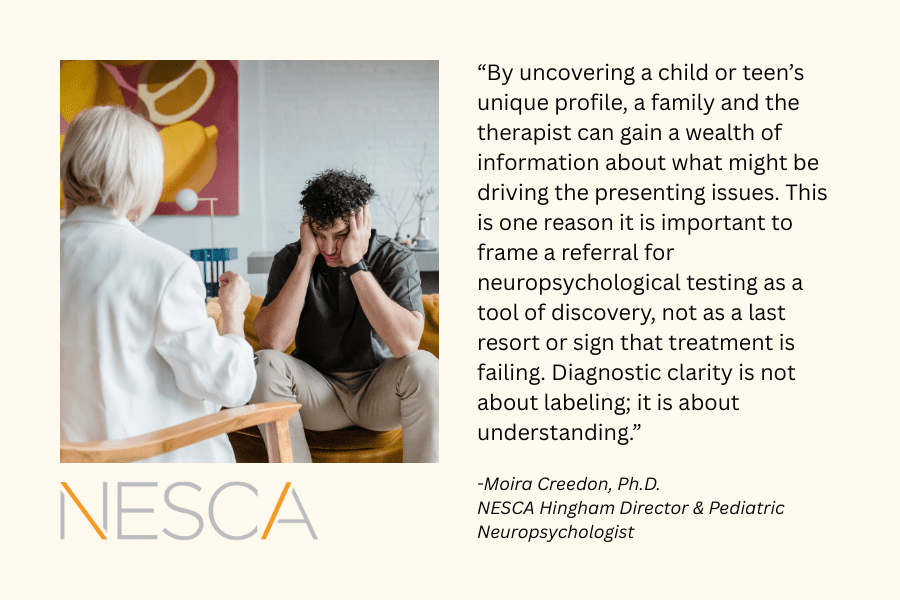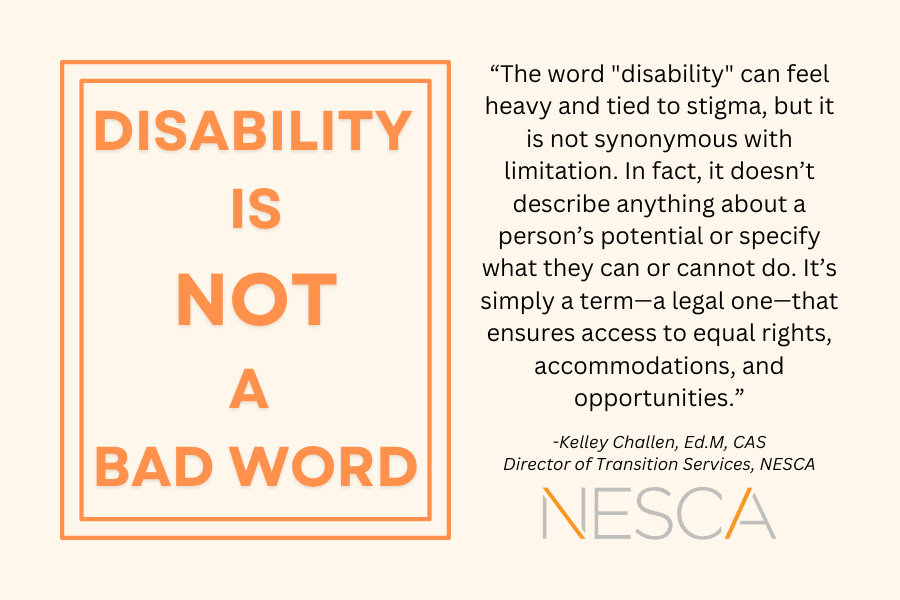
 By: Moira Creedon, Ph.D.
By: Moira Creedon, Ph.D.
NESCA Hingham Director & Pediatric Neuropsychologist
Sometimes therapy hits a wall. A child or teen may be attending sessions regularly but still seems “stuck.” They might be unable to make progress, reluctant to engage, or struggling in ways that don’t fully add up. Even the most dedicated clients, those who do their therapy “homework” and participate openly, may continue to face challenges outside of the therapy room. This can be both frustrating and confounding for everyone involved. In these situations, neuropsychological testing does not have to be a last resort. It can be a powerful, collaborative tool that helps uncover what might be happening or why certain obstacles keep getting in the way. By clarifying diagnoses, identifying how a child or teen processes information, and highlighting cognitive or emotional patterns, neuropsychological testing offers insight that can shape therapeutic work to offer meaningful change.
There are few key gaps that neuropsychological testing can help to fill that are not a part of the normal course of therapy. First, neuropsychologists tend to get more extensive histories across all domains. Often times, therapists get some history about the presenting symptoms right away, but then they quickly have to dive into supporting a child, building rapport, providing psychoeducation, or practicing new coping strategies.
Neuropsychologists tend to get data across a broader range of developmental patterns for a holistic understanding of how the child has developed. Secondly, neuropsychologists then get concrete, quantifiable data on how a child or teen processes information – what their cognition is, how they encode and store information in their memory, how they tackle a hard problem, how they interpret a social challenge, and how they reflect on their own emotional experience. The focus is on how a person processes information, not just what their current symptoms are.
Why is this important? Take, for example, the case of a recent 16-year-old seen for neuropsychological testing who was in therapy for years due to a general sense of worry. Neuropsychological testing helped to highlight problems with cognitive flexibility, poor working memory, and distractibility. In addition to her anxiety, she was also struggling with ADHD. Lapses in attention were making her more anxious, leading her to long hours studying, blaming herself for her shortcomings. these long study sessions were disorganized and inefficient because of inherent executive functioning problems.
Take another example of a younger child who was 7-years-old. His parents felt frustrated by his dysregulated behaviors at home. He was disengaged in therapy and seemed unable to talk with his parents about what was going on after a big incident. Neuropsychological testing helped to undercover significant problems with language processing. This led to more frustration as he could not explain why he was upset, and traditional “talk therapy” methods had to be adapted so that language was simple and concrete.
By uncovering a child or teen’s unique profile, a family and the therapist can gain a wealth of information about what might be driving the presenting issues. This is one reason it is important to frame a referral for neuropsychological testing as a tool of discovery, not as a last resort or sign that treatment is failing. Diagnostic clarity is not about labeling; it is about understanding. It is a process of giving a complete picture of a child or teen’s functioning, seeking alternative pathways for change, and capitalizing on the client’s strengths.
With new information provided in neuropsychological testing, therapists can collaborate with a neuropsychologist to individualize treatment. Here are some examples for how testing can help therapists:
- A therapist can slow down their interventions and offer more repetition for children with processing speed troubles.
- A therapist can use simplified language for a child with cognitive impairments or reduced language skills.
- A therapist can reduce the “homework” they assign for a teen with weak working memory and executive functioning deficits.
- A therapist can pull in a new evidence-based treatment when anxiety veers into a pattern of intense obsessions and compulsive behaviors in a teen with OCD.
- A therapist can support a teen overwhelmed with anxiety when facing a mountain of assignments at school if their executive functioning challenges make it hard for them to break down these tasks into smaller steps.
- A therapist can explore the opportunity to collaborate with an executive functioning coach, group therapy program, or psychiatrist if a child’s profile suggests this is helpful.
When therapy stalls, it doesn’t mean a child isn’t trying or the treatment isn’t helpful. It might mean we are missing part of the picture. Neuropsychological testing can offer the insight needed to move forward with greater compassion, precision, and effectiveness.
Being “stuck” does not have to be seen as a sign of failure. It can be a turning point or an opportunity to uncover processing patterns that shift the focus from blame to change. When testing and therapy work hand in hand, they offer families not just answers, but a compassionate and informed way forward.
About the Author
Dr. Creedon offers her expertise in evaluating children and teens with a variety of presenting issues. She is interested in uncovering an individual’s unique pattern of strengths and weaknesses to best formulate a plan for intervention and success. She tailors each assessment to address a range of referral questions, such as developmental disabilities, including Autism Spectrum Disorder, learning disabilities, attention challenges, executive functioning deficits, and social-emotional struggles. She also evaluates college-/grad school-age/adult individuals with developmental issues, such as ASD and ADHD, particularly when there is a diagnostic clarity or accommodation question.
is interested in uncovering an individual’s unique pattern of strengths and weaknesses to best formulate a plan for intervention and success. She tailors each assessment to address a range of referral questions, such as developmental disabilities, including Autism Spectrum Disorder, learning disabilities, attention challenges, executive functioning deficits, and social-emotional struggles. She also evaluates college-/grad school-age/adult individuals with developmental issues, such as ASD and ADHD, particularly when there is a diagnostic clarity or accommodation question.
If you are interested in booking an evaluation with Dr. Creedon or another NESCA neuropsychologist, please fill out and submit our online intake form.
NESCA is a pediatric neuropsychology practice and integrative treatment center with offices in Newton, Plainville, and Hingham, Massachusetts; Londonderry, New Hampshire; and the greater Burlington, Vermont region, serving clients from infancy through young adulthood and their families. For more information, please email info@nesca-newton.com or call 617-658-9800.



 Boston area since 2006. He specializes in the assessment of children and adolescents who present with a wide range of developmental conditions, such as Attention-Deficit/Hyperactivity Disorder, Specific Learning Disorder (reading, writing, math), Intellectual Disability, and Autism Spectrum Disorder; as well as children whose cognitive functioning has been impacted by medical, psychiatric, and genetic conditions. He also has extensive experience working with children who were adopted both domestically and internationally.
Boston area since 2006. He specializes in the assessment of children and adolescents who present with a wide range of developmental conditions, such as Attention-Deficit/Hyperactivity Disorder, Specific Learning Disorder (reading, writing, math), Intellectual Disability, and Autism Spectrum Disorder; as well as children whose cognitive functioning has been impacted by medical, psychiatric, and genetic conditions. He also has extensive experience working with children who were adopted both domestically and internationally.


 attention deficit disorders, communication disorders, intellectual disabilities, and learning disabilities. She particularly enjoys working with children and their families who have concerns regarding an autism spectrum disorder. Dr. Milana has received specialized training on the administration of the Autism Diagnostic Observation Schedule (ADOS).
attention deficit disorders, communication disorders, intellectual disabilities, and learning disabilities. She particularly enjoys working with children and their families who have concerns regarding an autism spectrum disorder. Dr. Milana has received specialized training on the administration of the Autism Diagnostic Observation Schedule (ADOS).


 young adults with diverse developmental and learning abilities. Since 2013, she has served as Director of Transition Services at NESCA, offering individualized transition assessments, planning, consultation, coaching, and program development. She specializes in working with students with complex profiles who may not engage with traditional testing tools or programs. Ms. Challen holds a BA in Psychology and a Minor in Hispanic Studies from The College of William and Mary, along with a Master’s and Certificate of Advanced Graduate Study in Risk and Prevention Counseling from the Harvard Graduate School of Education. She is a member of CEC, DCDT, and COPAA, believing it’s vital for all IEP participants to have accurate information about transition planning. Ms. Challen has also been actively involved in the MA DESE IEP Improvement Project, mentored candidates in UMass Boston’s Transition Leadership Program, and co-authored a chapter in Technology Tools for Students with Autism.
young adults with diverse developmental and learning abilities. Since 2013, she has served as Director of Transition Services at NESCA, offering individualized transition assessments, planning, consultation, coaching, and program development. She specializes in working with students with complex profiles who may not engage with traditional testing tools or programs. Ms. Challen holds a BA in Psychology and a Minor in Hispanic Studies from The College of William and Mary, along with a Master’s and Certificate of Advanced Graduate Study in Risk and Prevention Counseling from the Harvard Graduate School of Education. She is a member of CEC, DCDT, and COPAA, believing it’s vital for all IEP participants to have accurate information about transition planning. Ms. Challen has also been actively involved in the MA DESE IEP Improvement Project, mentored candidates in UMass Boston’s Transition Leadership Program, and co-authored a chapter in Technology Tools for Students with Autism.



 Deficit Hyperactivity Disorder (ADHD), Nonverbal Learning Disability (NVLD), and executive functioning disorders (e.g. slow processing speed). She also has experience in working with individuals with psychiatric difficulties, such as anxiety, mood disorders (e.g. depression), and behavioral disorders. Dr. Weinberg has expertise in working with children with complex profiles or multiple areas of strength and weakness that cannot be encapsulated by a single diagnosis. Dr. Weinberg is passionate about helping families better understand their child’s neuropsychological profile and the impact it may be having on their behavior or functioning in order to best support them in all areas of their life.
Deficit Hyperactivity Disorder (ADHD), Nonverbal Learning Disability (NVLD), and executive functioning disorders (e.g. slow processing speed). She also has experience in working with individuals with psychiatric difficulties, such as anxiety, mood disorders (e.g. depression), and behavioral disorders. Dr. Weinberg has expertise in working with children with complex profiles or multiple areas of strength and weakness that cannot be encapsulated by a single diagnosis. Dr. Weinberg is passionate about helping families better understand their child’s neuropsychological profile and the impact it may be having on their behavior or functioning in order to best support them in all areas of their life.
Connect with Us